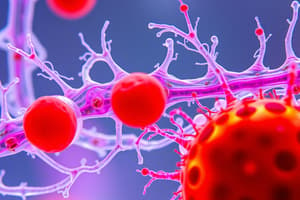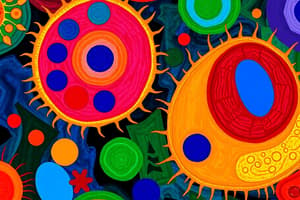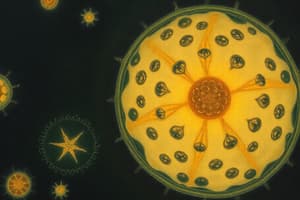Podcast
Questions and Answers
What distinguishes multicellular organisms from colonial organisms?
What distinguishes multicellular organisms from colonial organisms?
Multicellular organisms have specialized cells that perform specific functions and coordinate their activities, while colonial organisms consist of genetically identical cells living together with little coordination.
List three characteristics of life that apply to all living organisms.
List three characteristics of life that apply to all living organisms.
All living organisms are composed of cells, obtain and use energy, and reproduce.
How do unicellular organisms obtain energy compared to multicellular organisms?
How do unicellular organisms obtain energy compared to multicellular organisms?
Unicellular organisms obtain energy through processes like photosynthesis or fermentation, while multicellular organisms often have specialized cells for energy acquisition, such as roots in plants.
Explain the concept of homeostasis in living organisms.
Explain the concept of homeostasis in living organisms.
Which types of organisms are classified as unicellular, and provide two examples.
Which types of organisms are classified as unicellular, and provide two examples.
What significant contribution did Robert Hooke make in 1665 regarding cell discovery?
What significant contribution did Robert Hooke make in 1665 regarding cell discovery?
How did Anton van Leeuwenhoek's microscopes improve our understanding of microorganisms?
How did Anton van Leeuwenhoek's microscopes improve our understanding of microorganisms?
What key conclusion did Matthias Schleiden and Theodor Schwann reach about living organisms in the late 1830s?
What key conclusion did Matthias Schleiden and Theodor Schwann reach about living organisms in the late 1830s?
What does the cell theory state about the origins of new cells?
What does the cell theory state about the origins of new cells?
Explain how cell diversity relates to their functions within an organism?
Explain how cell diversity relates to their functions within an organism?
What is the role of the mitochondria in an animal cell?
What is the role of the mitochondria in an animal cell?
Describe the function of the lysosome in an animal cell.
Describe the function of the lysosome in an animal cell.
What is the primary function of the rough endoplasmic reticulum?
What is the primary function of the rough endoplasmic reticulum?
Explain the role of the nucleus in an animal cell.
Explain the role of the nucleus in an animal cell.
What is the purpose of the cell membrane in an animal cell?
What is the purpose of the cell membrane in an animal cell?
What are the main structural components of a prokaryotic cell?
What are the main structural components of a prokaryotic cell?
How do eukaryotic cells differ from prokaryotic cells in terms of organelles?
How do eukaryotic cells differ from prokaryotic cells in terms of organelles?
What role did cyanobacteria play in changing Earth's environment?
What role did cyanobacteria play in changing Earth's environment?
Describe the function of ribosomes in bacterial cells.
Describe the function of ribosomes in bacterial cells.
What is the significance of the cell membrane in both prokaryotic and eukaryotic cells?
What is the significance of the cell membrane in both prokaryotic and eukaryotic cells?
Who developed the binomial nomenclature system and what is its significance?
Who developed the binomial nomenclature system and what is its significance?
What are the two primary groups into which Aristotle first classified living organisms?
What are the two primary groups into which Aristotle first classified living organisms?
Describe the concept of a species in biological classification.
Describe the concept of a species in biological classification.
In the classification levels, what does the acronym 'Dear King Philip Came Over For Good Soup' help to remember?
In the classification levels, what does the acronym 'Dear King Philip Came Over For Good Soup' help to remember?
What distinguishes Archaebacteria from Eubacteria in terms of cell structure?
What distinguishes Archaebacteria from Eubacteria in terms of cell structure?
Why is structural similarity important in the classification of organisms?
Why is structural similarity important in the classification of organisms?
Identify one example of an organism classified in the Fungi kingdom and its mode of nutrition.
Identify one example of an organism classified in the Fungi kingdom and its mode of nutrition.
What are the characteristics of the Eukarya domain's Protista kingdom?
What are the characteristics of the Eukarya domain's Protista kingdom?
What is the function of chloroplasts in plant cells?
What is the function of chloroplasts in plant cells?
Describe the role of the large central vacuole in plant cells.
Describe the role of the large central vacuole in plant cells.
What does the endosymbiosis theory propose about eukaryotic cells?
What does the endosymbiosis theory propose about eukaryotic cells?
How do chromoplasts benefit plants?
How do chromoplasts benefit plants?
What is the difference between rough ER and smooth ER in plant cells?
What is the difference between rough ER and smooth ER in plant cells?
What key evidence supports the endosymbiosis theory regarding the structure of mitochondria and chloroplasts?
What key evidence supports the endosymbiosis theory regarding the structure of mitochondria and chloroplasts?
Who developed the endosymbiosis theory, and in which decade was it proposed?
Who developed the endosymbiosis theory, and in which decade was it proposed?
Describe the transformation process from a prokaryotic ancestor to an ancestral eukaryote in the context of the endosymbiosis theory.
Describe the transformation process from a prokaryotic ancestor to an ancestral eukaryote in the context of the endosymbiosis theory.
What similarities in protein sequences are observed in mitochondria and chloroplasts that support the endosymbiosis theory?
What similarities in protein sequences are observed in mitochondria and chloroplasts that support the endosymbiosis theory?
In what sequential order do the stages of endosymbiosis occur according to the theory?
In what sequential order do the stages of endosymbiosis occur according to the theory?
What are the two parts that make up a scientific name in binomial nomenclature?
What are the two parts that make up a scientific name in binomial nomenclature?
Why are all scientific names written in Latin?
Why are all scientific names written in Latin?
What is meant by cell differentiation?
What is meant by cell differentiation?
What limits the size of a cell?
What limits the size of a cell?
Identify a key role of cell membranes in cell function.
Identify a key role of cell membranes in cell function.
How should a scientific name be formatted when typed?
How should a scientific name be formatted when typed?
Which animals in the practice problem are closely related and how do you determine that?
Which animals in the practice problem are closely related and how do you determine that?
What is the significance of the surface area-to-volume ratio for cell function?
What is the significance of the surface area-to-volume ratio for cell function?
What role do ribosomes play in cellular functions?
What role do ribosomes play in cellular functions?
How does mitochondrial inheritance occur in humans?
How does mitochondrial inheritance occur in humans?
What is the primary function of Golgi bodies in cells?
What is the primary function of Golgi bodies in cells?
Distinguish between the functions of cilia and flagella.
Distinguish between the functions of cilia and flagella.
What is the function of vesicles in cellular processes?
What is the function of vesicles in cellular processes?




